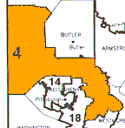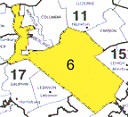| Pennsylvania’s Political Lineup
|
Redistricting Deadline There is no specific deadline for congressional districts. A preliminary plan must be filed 90 days from certification of the reapportionment commission or receipt of census data for the state legislative plan After the preliminary plan is filed, parties have 30 days to file exceptions. The legislature must adopt a plan within 30 days of the last exception filed. Aggrieved parties can appeal. | Who’s in Charge of Redistricting? The Pennsylvania General Assembly is in charge of congressional redistricting. The five-member Legislative Reapportionment Commission handles state legislative redistricting. The leaders of the four caucuses in the legislature, or their designees are members of the commission. The four members must pick a fifth member or the state Supreme Court will do so after 30 days. The governor only has veto power over the congressional plan. | ||||||||||||||||||||||||
Districting Principles
| Public Access The preliminary plan is published in all daily newspapers. During the time for filing exceptions, public hearings are held for citizens to present testimony and offer their own plans. Political Landscape In 1950, Pennsylvania had 32 U.S. House Members. Its delegation has lost at least two House members in every round of redistricting since that year and will be down to 19 in 2002. The state’s population declines have taken place in Democratic areas, meaning that Democrats easily could lose at least three – and as many as five – of their current 11 seats because Republicans have monopoly control of congressional redistricting in 2001. |
Legal Issues Pennsylvania faced a great deal of redistricting litigation in the 1990’s. Pennsylvania Legislative Reapportionment Commission’s district plan was challenged in both state and federal court in 1992. The state court plaintiffs claimed a laundry list of violations, including state constitutional compactness and contiguity violations, equal population and political subdivision boundary violations and Equal Protection and Voting Rights Act claims. The state court dismissed all of these claims. The federal court claim was a minority vote dilution challenge under section 2 of the Voting Rights Act. Specifically, the plaintiffs objected to the fact that none of the four of Philadelphia's majority-black state legislative districts had a total population of at least 65%, deemed a safe percentage to ensure black voters would elect a candidate of choice. The court refused to accept 65% as the required percentage of black voters to create a majority-black district, noting that a substantial number of white voters in the disputed districts voted along with blacks.Suggestions of such white “crossover voting” were also significant in a minority vote dilution claim against a court-drawn congressional district plan in 1992. Pointing to the history of strong black voter participation and substantial white voter support of black candidates in Philadelphia, a state court upheld two congressional districts with a 52% and 62% black population .A state court also dismissed an equal population claim in 1992 on the basis that the plan's minimal population deviations were created in an effort to avoid splitting political subdivisions. A federal district court dismissed similar claims. |
Irregularly Shaped District | Irregularly Shaped District |
|
|
| · South and central Philadelphia; includes parts of Chester · Large Italian population; also black and union · Lowest median income of all districts in the state · Very Democratic, with white representative · 38% white; 52% black; 2% Asian; 9% Hispanic | · Includes Beaver Co., part of Westmoreland Co.; wraps around northern part of Pittsburgh · Historically heavily union and Democratic, but trending Republican
· 96% white; 3% black |
Irregularly Shaped District | Irregularly Shaped District |
|
|
· Southeast PA; Reading | · In southwest—the Mon Valley; Washington · Swing district, represented by Democrats in the 1990’s · 96% white; 3% black |
Contact Information Kathy A. Sullivan Robert L. Evangelista |




